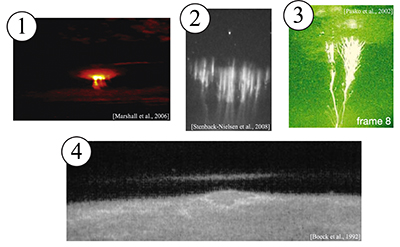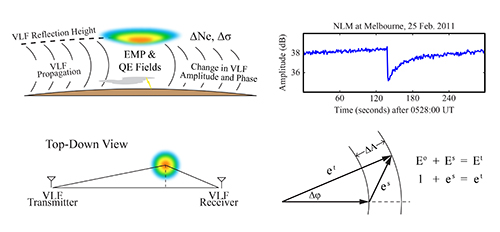Ionospheric Effects of Lightning
Particularly strong forms of lightning can produce fanstastic optical displays at 60-100 km altitude. Sprites, sprite halos, elves, and gigantic jets (see Figure 1) are collectively known as Transient Luminious Events (TLEs), and they exemplify the direct coupling of lightning energy to the overlying ionosphere. While these effects are often studied using optical detectors, such as high-speed cameras and photometric arrays, our research group uses the VLF remote sensing method. TLEs are strongly associated with conductivity changes in the lower ionosphere, and these conductivity changes affect VLF wave propagation in the Earth-ionosphere waveguide.

VLF transmitters in the 20-30 kHz range are operated by navies worldwide for submarine communications, and we use these transmissions as signals-of-opportunity to detect ionospheric conductivity changes associated with TLEs. Disturbances in the lower ionosphere scatter VLF radio waves, producing changes in the received amplitude and phase of subionospherically propagating VLF signals (see Figure 2). Certain types of perturbations occur within 20 msecs of a causative lightning flash, indicative of direct ionospheric coupling associated with TLEs. Other types of events exhibit delays on the order of seconds, and may be associated with lightning-induced electron precipitation from the Earth's radiation belts.

References
Barrington-Leigh, C. P., U. S. Inan, and M. Stanley (2001), Identification of sprites and elves with intensified video and broadband array photometry, J. of Geophys. Res., 106(A2), 1741-1750.
Boeck, W. L., O. H. Vaughan Jr., R. Blakeslee, B. Vonnegut, and M. Brook (1992), Lightning induced brightening in the airglow layer, Geophys. Res. Lett., 19(2), 99-102.
Franz, R. C., R. J. Nemzek, and J. R. Winckler (1990), Television image of a large upward electrical discharge above a thunderstorm system, Science, 249.
Lyons, Walter A. (2006), The Meteorology of Transient Luminous Events – An Introduction and Overview, in Sprites, Elves, and Intense Lightning Discharges, edited by M. Füllekrug et al., pp. 19-56, Springer, Netherlands.
Marshall, R. A., U. S. Inan, and W. A. Lyons (2006), On the association of early/fast very low frequency perturbations with sprites and rare examples of VLF backscatter, J. of Geophys. Res., 111, D19108.
Pasko, V. P., M. A. Stanley, J. D. Matthews, U. S. Inan, and T. G. Wood (2002), Electrical discharge from a thundercloud top to the lower ionosphere, Nature, 416, 152-154.
Stenbaek-Nielsen, H. C., and M. G. McHarg (2008), High time-resolution sprite imaging: observations and implications, J. Phys. D: Appl. Phys., 41, 234009.
Stenbaek-Nielsen, H. C., R. Haaland, M. G. McHarg, B. A. Hensley, and T. Kanmae (2010), Sprite initiation altitude measured by triangulation, J. of Geophys. Res., 115, A00E12.

